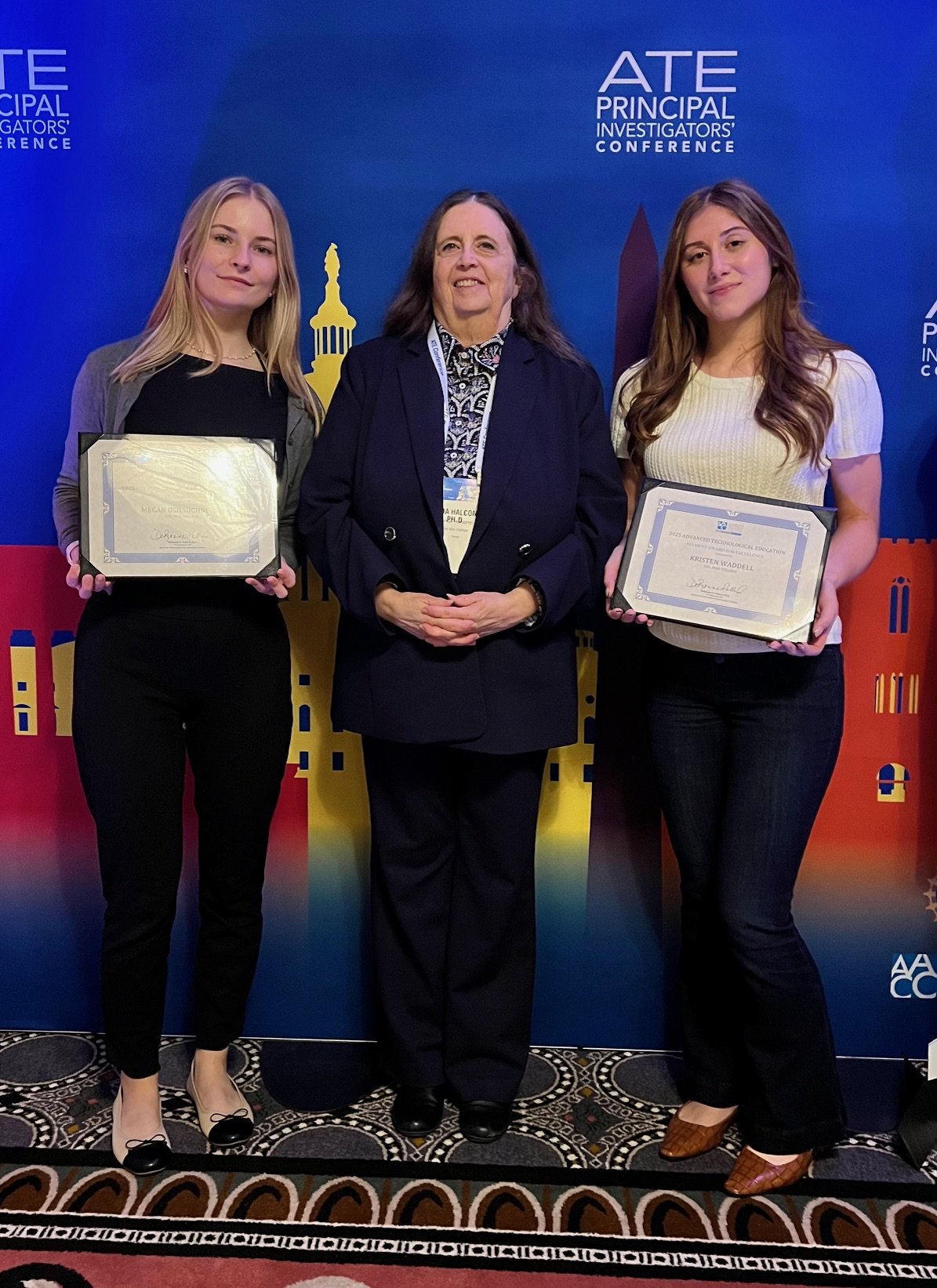Two DMC Biotechnology Students Earn “Award for Excellence” for Research
Del Mar College
Del Mar College students Megan O'Shaughnessy and Kristen Waddell, both Biology and Biotechnology majors, recently experienced earn “Award for Excellence” led by DMC Natural Sciences Department faculty member and mentor Dr. Daiyuan “Daisy” Zhang, Professor of Biotechnology, and accompanied by Vice President and Chief Academic Officer Dr. Jonda Halcomb. The Viking pair attended the 32nd National Advanced Technical Education (ATE) Principal Investigators’ Conference held in Washington, D.C. Oct. 29-31.
Dr. Jonda Halcomb, Del Mar College Vice President and Chief Academic Officer, was on hand to see students Megan O’Shaughnessy (left) and Kristen Waddell receive an Award for Excellence at the 32nd National Advanced Technical Education (ATE) Principal Investigators’ Conference held in Washington, D.C. Oct. 29-31.
During the conference, O’Shaughnessy presented her research poster examining whether the extracellular vesicles (EVs) found in the blood of the Western Diamondback Rattlesnake and the Virgina opossum could protect these animals from rattlesnake venom. Her results show that the EVs from the snake and the opossum did weaken the venom, making it less able to break down fibrinogen, which helps blood clot, and gelatin, which is like the material found in tissues.
O’Shaughnessy, who graduated from Kingwood High School and the Texas Connections Academy in 2022, said her favorite experience during the trip was presenting her research poster to a range of professionals working in STEM fields.
“Being able to break down my poster to people at different levels definitely increased my confidence in my knowledge of my project and made me a better presenter,” O’Shaughnessy said. “Del Mar College has provided me with so many opportunities and experiences that have made a big difference on my confidence as a student.”
Waddell’s poster focused on a very local and critical area of concern––environmental pollution in Baffin Bay. Baffin Bay and the creeks that flow into it are used for ranching, farming, fishing, bird-watching and other outdoor activities.
But some of these waters have a problem. They contain too much fecal bacteria, which can come from humans or animals, which pollutes the environment.
Scientists are already studying where this pollution comes from—cows, pigs, humans and birds. And in this project, researchers have added another tool to help track pollutants: a special gene called Class 1 Integron-Integrase gene, or intI1. This gene is important because it is often found in bacteria that carry antibiotic resistance that can be harmful.
Including Waddell, researchers collected 142 water samples from Baffin Bay and three nearby creeks. The gene was present in every test site with some places having more than others. San Fernando Creek had the most, followed by Los Olmos Creek, Petronila Creek and then the bay. The amount of the intI1 gene also increased when there were more signs of poop from humans, cows and pigs.
This means the intI1 gene is a good clue for spotting pollution caused by people and their activities. Adding this gene to water-testing studies will help scientists better understand how fecal pollution and antibiotic-resistant bacteria spread in the environment.
Waddell, who graduated from Veterans Memorial High School in 2023, said she especially enjoyed having a meaningful conversation with a Florida researcher who was interested in the genetics side of her research.
“I loved hearing how his lab approached the same techniques I was using as they were incredibly innovative and inventive,” Waddell said. “This conversation was inspirational, and I saw the significance of continuing research in this area.”
Dr. DeRionne Pollard, President and CEO of co-sponsor American Association of Community Colleges, noted that 800 National Science Foundation grantees attended the conference and remarked that the conference provided students and faculty with remarkable opportunities to share their work and learn from others.
“Helping students see pathways from learning to application in the workplace builds the pipeline of skilled workers in our economy,” Pollard said, adding: “Since economic stability drives further innovation in businesses, these are investments in our shared futures.”
For O’Shaughnessy and Waddell, attending this year’s ATE Principal Investigators’ Conference is one step among many toward bringing their own innovation to STEM professions that will benefit us all.




